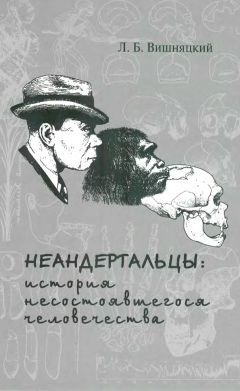Oliva M Die Herkunft des Szeletien im Likhte neuer Funde von Jeserany // Casopis Moravskeho Muzea v Brne, 1979. N 64. P. 45-78.
Oliva M. Pointes foliacees et technique levallois dans le passage paleolithique moyen/paleolithique superieur en Europe centrale // J. Kozlowski (ed). L'Homme de Neandertal. Vol. 8. La Mutation. Liege: ERAUL, 1988. P. 125-131.
Onac B. P., Viehmann /., Lundberg J., Lauritzen S.-E., Stringer C., Popifa V. U-Th ages constraining the Neanderthal footprint at Vartop Cave, Romania // QSR. 2005. N24. P. 1151-1157.
Oppenheimer S. The great arc of dispersal of modern humans: Africa to Australia // QI.N202. P. 2-13.
Orlando L., Darlu P., Toussaint M, Bonjean D., Otte M, Hanni C. Revisiting Neandertal diversity with a 100,000 year old mtDNA sequence // CB. 2006. N 16. P. 400-402.
Orschiedt J. Der Fall Krapina — neue Ergebnisse zur Frage van Kannibalismus beim Neandertaler // Quartar. 2008. N 55. P. 63-81.
Patou-Mathis M. Neanderthal subsistence behaviours in Europe // IJO. 2000. N 10. P. 379-395.
PatteE. LesNeandertaliens: anatomie, physiologie, comparasions. Paris: Masson, 1955.
Paunescu A. Le Paleolithique et le Mesolithique de Roumanie (un bref aper?u) // L'Anthropologic. 1989. N 93. P. 123-58.
Pearson J. A. Hunters, fishers and scavengers: a review of the isotope evidence for Neanderthal diet // BF 2, article 2. 2007.
Pearson О. M. Has the combination of genetic and fossil evidence solved the riddle of modern human origins // EA. 2004. N 13. P. 145-159.
Pearson О. M, Cordero R. M, Busby A. M. How different were Neanderthals' habitual activities? A comparative analysis with diverse groups of recent humans // K. Harvati and T. Harrison (eds). Neanderthals Revisited: New Approaches and Perspectives. Dordrecht: Springer, 2006. P. 135-156.
Pennington R. Hunter-gatherer demography // C. Panter-Brick, R. H. Layton, P. Rowley-Conwy (eds). Hunter-Gatherers. An Interdisciplinary Perspective. Cambridge: Cambridge University Press, 2001. P. 170-204.
Pennisi E. Tales of a prehistoric human genome // Science. 2009. N 323. P. 866- 871.
Perez-Perez A., Espurz V., Bermudez de Castro J. M., Lumley M. A. deTurbon D. Non-occlusal dental microwear variability in a sample of Middle and Late Pleistocene human populations from Europe and the Near East // JHE. 2003. N 44. P. 497-513.
Pettitt P. В. Disappearing from the world: an archaeological perspective on Neanderthal extinction // OJA. 1999. N 18. P. 217-40.
Pettitt P. B. Neanderthal lifecycles: developmental and social phases in the lives of the last archaics // WA. 2000. N 31. P. 351-366.
Pettitt P. В. The Neanderthal dead: exploring mortuary variability in Middle Palaeolithic Eurasia // BF 1, article 4. 2002.
Plavcan J. M. Sexual dimorphism in primate evolution// YPA. 2001. N 44. P. 25-53.
Ponce de Leon M. S., Golovanova L., Doronichev K, Romanova G.,Akazawa Т., Kondo O., Ishida H, Zollikofer С. P. E. Neanderthal brain size at birth provides insights into the evolution of human life history // PNAS. 2008. N 16. P. 13764-13768.
RahmstorfS. Ocean circulation and climate during the past 120,000 years //Nature. 2002. N419. P. 207-214.
Rak Y. The Neanderthal: A new look at an old face // JHE. 1986. N 15. P. 151-164.
Rak 7., GinzburgA., Geffen E. Does Homo neanderthalensis play a role in modern human ancestry? The mandibular evidence // AJPA. 2002. N 119. P. 199-204.
Ramirez Rozzi F. V., d'Errico F., Vanhaeren M, Grootes P. M, Kerautret В., Dujardin V. Cutmarked human remains bearing Neandertal features and modern human remains associated with the Aurignacian at Les Rois // JAnS. 2009. N 87. P. 1-30.
Rampino M. R., Self S. Volcanic winter and accelerated glaciation following the Toba super-eruption //Nature. 1992. N 359. P. 50-52.
Rhodes J. A., Churchill S. E. Throwing in the Middle and Upper Paleolithic: inferences from an analysis of humeral retroversion // JHE. 2009. N 56. P. 1-10.
Richards M. P. Diet shift at the Middle/Upper Palaeolithic transition in Europe? The stable isotope evidence // W. Roebroeks (ed). Guts and Brains. An Integrative
Approach to the Hominin Record. Leiden: Leiden University Press, 2007. P. 221- 234.
Richards M. P., Trinkaus E. Isotopic evidence for the diets of European Neanderthals and early modern humans // PNAS. 2009. N 16. P. 16034-16039.
Richards M, Harvati K., Grimes V., Smith C., Smith Г., Hublin J.-J., Karkanas P., Panagopoulou E. Strontium isotope evidence of Neanderthal mobility at the site of Lakonis, Greece using laser-ablation PIMMS // JHE. 2008a. N 35. P. 1251-1256.
Richards M. PTaylor G., Steele Г., McPherron S. PSoressi M, Jaubert J., Orschiedt У., Mallye J. В., Rendu W., Hublin J.-J. Isotopic dietary analysis of a Neanderthal and associated fauna from the site of Jonzac (Charente-Maritime), France // JHE. 2008b. N 55. P. 179-185.
Riel-Salvatore J., Clark G. A. Grave markers. Middle and Early Upper Paleolithic burials and the use of chronotypology in contemporary Paleolithic research // CAn. 2001. N 42. P. 449-479.
Rightmire G. P. Human evolution in the Middle Pleistocene: the role of Homo heidelbergensis II EA. 1998. N 6. P. 218-227.
Rightmire G. P. Homo in the Middle Pleistocene: hypodigms, variation, and species recognition // EA. 2008. N 17. P. 8-21.
Rightmire G. P. Middle and later Pleistocene hominins in Africa and Southwest Asia // PNAS. 2009. N 106. P. 16046-16050.
Robson S. L., Wood B. Hominin life history: reconstruction and evolution // JA. 2008. N212. P. 394-425.
Roebroeks W. Time for the Middle to Upper Paleolithic transition in Europe // JHE. 2008. N55. P. 918-926.
Rogers A. R., litis D., Wooding S. Genetic variation at the MC1R locus and the time since loss of human body hair // CAn. 2004. N 45. P. 105-108.
Rolland N. Was the emergence of home bases and domestic fire a punctuated event? A review of the Middle Pleistocene record in Eurasia // Asian Perspectives.
2004. N43. P. 248-280.
Rosas A. Occurrence of Neanderthal features in mandibles from the Atapuerca-SH site // AJPA. 2001. N 114. P. 74-91.
Rosas AВ astir M, Martinez-Maza C., Garcia-Tabernero ALalueza-Fox C. Inquiries into Neanderthal craniofacial development and evolution: "accretion" versus organismic" models // K. Harvati and T. Harrison (eds). Neanderthals Revisited: New Approaches and Perspectives. Dordrecht: Springer, 2006. P. 37-69.
Rosen A. M. Middle Paleolithic plant exploitation: the microbotanical evidence // D. O. Henry (ed). Neanderthals in the Levant. Behavioral Organization and the Beginnings of Human Modernity. London/New York: Continuum, 2003. P. 156- 171.
RoucouxK. H.,AbreuL. de, ShackletonN. J., Tzedakis P. C. The response ofNW Iberian vegetation to North Atlantic climate oscillations during the last 65 kyr // QSR.
2005. N24. P. 1637-1653.
RoyerD. F., Lockwood C. A., Scott J. E., GrineF. E. Size variation in early human mandibles and molars from Klasies River, South Africa: Comparison with other
Middle and Late Pleistocene assemblages and with modern humans // AJPA. 2009. N 140. P. 312-323.
Rushton J. P. Cranial capacity related to sex, rank, and race in a stratified random sample of 6,325 U. S. military personnel // Intelligence. 1992. N 16. P. 401-413.
Santa Luca A. P. A re-examination of presumed Neanderthal-like fossils // JHE. 1978. N7. P. 619-636.
Sawyer G. У., Maley B. Neanderthal reconstructed // AR. 2005. N 283B. P. 23-31.
Sawyer R. J. Hominids. New York: Tom Doherty Associates, 2002.
Schaaffhausen H. Funde in der Sipkahohle in Mahren // Sonderbericht der Niederrheinischen Gesellschaft fur Natur- und Heilkunde. 1880. P. 260-264.
Schillaci M. A., Froehlich J. W. Nonhuman primate hybridization and the taxonomic status of Neanderthals//AJPA. 2001. N 116. P. 157-166.
SchickK. D., Toth N. Making Silent Stones Speak. Human Evolution and the Dawn of Technology. New York: Touchstone, 1994.
Schmitt D., Churchill S. E., Hylander W. L. Experimental evidence concerning spear use in Neandertals and early modern humans // JAS. 2003. N 30. P. 103— 114.
Schmitz R. W. The discovery of fossil man in the 18th and 19th century// R. W. Schmitz (ed). Neanderthal 1856-2006. Mainz am Rhein: Verlag Philipp von Zaibern, 2006a. P. 9-16.
Schmitz R. W. A romantic valley and a discovery that has changed the world // R. W. Schmitz (ed). Neanderthal 1856-2006. Mainz am Rhein: Verlag Philipp von Zaibern, 2006b. P. 35-44.
Schrenk F., Muller S. The Neanderthals. New York: Routledge, 2009. (Transl. from 2005 Germ, ed.)
Schwalbe G. Uber die specifischen Merkmale des Neanderthalschadels // Verbandlungen der Anatomische Gesselschaft: Erganzbeft zur Anatomische Anzeiger 19, 1901. P. 44-61.
Schwalbe G. Studien zur Vorgeschichte des Menschen: I. Zur Frage der Abstammung des menschen. Stuttgart: E. Scheizerbart, 1906.
Schwartz J. H., Tattersall I., Laitman J. T. New thoughts on Neanderthal behavior: Evidence from nasal morphology // H. Ullrich (ed). Hominid Evolution: Lifestyles and Strategies. Gelsenkirchen; Schwelm: Edition Archaea, 1999. P. 166-186.
Schwartz J. H., Tattersall I., Teschler-Nicola M. Architecture of the nasal complex in Neanderthals: Comparison with other hominids and phylogenetic significance // AR. 2008. N 291. P. 1517-1534.
Semal P., Rougier H., Crevecoeur I., Jungels C., Flas D., Hauzeur A., Maureille В., Germonpre M.,Bocherens H., Pirson SCammaertL., ClerckN. De, Hambucken A., Higham Т., Toussaint M., Plicht J. van der. New data on the late Neandertals: Direct dating of the Belgian Spy fossils // AJPA. 2009. N 138. P. 421-428.
Semendeferi K., Damasio H., Frank R., Hoesen G. W. van. The evolution of the frontal lobes: a volumetric analyses based on three dimensional reconstructions of magnetic resonance scans of human and ape brains // JHE. 1997. N 32. P. 375- 388.
Serangeli У, Bolus М. Out of Europe — The dispersal of a successful European hominin form // Quartar. 2008. N 55. P. 83-98.
Serre D., Paabo S. The fate of European Neanderthals: results and perspectives from ancient DNA analyses // K. Harvati, T. Harrison (eds). Neanderthals Revisited: New Approaches and Perspectives. Dordrecht: Springer, 2006. P. 211-219.
Shang H., Tong H., Zhang S., Chen F., Trinkaus E. An early modern human from Tianyuan cave, Zhoukoudian, China // PNAS. 2007. N 104. P. 6573-6578.
Shea J. У, Sisk M. L. Complex projectile technology and Homo sapiens dispersal into Western Eurasia // PA. 2010. P. 100-122.
Shen G., Wang, Cheng H., Edwards R. L. Mass spectrometric U-series dating of Laibin hominid site in Guangxi, southern China// JAS. 2007. N 35. P. 2109- 2114.
ShreeveJ. The Neandertal Enigma: Solving the Mystery of Modern Human Origins. New York: William Morrow and Company, 1995.
Slimak L. Circulations de materiaux tres exotiques au Paleolithique moyen, une notion de detail // BSPF. 2008. N 105. P. 267-281.
Smith F. H. Upper Pleistocene hominid evolution in South-Central Europe: A review of the evidence and analysis of trends // CAn. 1982. N 23. P. 667- 703.
Smith F. H. Species, populations, and assimilation in later human evolution // C. S. Larsen (ed). A Companion to Biological Anthropology. Chichester: Wiley- Blackwell. P. 357-378.
Smith F. H.,Jankovic /., Karavanic I. The assimilation model, model human origins in Europe, and the extinction of Neandertals // QI. 2005. N 137. P. 7-19.
Smith Т. M, Harvati K., Olejniczak А. У, Reid D. J., Hublin J.-J., Panagopoulou E. Brief communication: dental development and enamel thickness in the Lakonis Neanderthal molar // AJPA. 2009. N 138. P. 112-118.
Snodgrass J. J., Leonard W. R. Neandertal energetics revisited: insights into population dynamics and life history evolution // PA. 2009. P. 220-237.
Soares P., Achilli A., Semino O., Davies W., Macaulay K, Bandelt H.-J., TorroniA., Richards M. B. The Archaeogenetics of Europe // CB. 2010. N 20. R174- R183.
Sommer M. Mirror, mirror on the wall: Neanderthal as image and 'distortion' in early 20th-century French science and press // SSS. 2006. N 36. P. 207-240.





